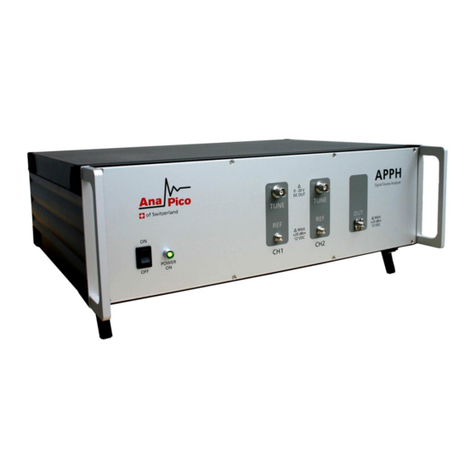
Page 3 – Signal Source Analyzers – v3.0 May 2019 AnaPico Ltd. - www.anapico.com – sales@anapico.com
Installing the APPH Graphical User Interface (APPH GUI)........................................................................... 16
Troubleshooting the LAN Interconnection................................................................................................... 17
Shutting Down the APPH............................................................................................................................. 17
Perform Firmware Upgrade ........................................................................................................................ 17
Serial Number.............................................................................................................................................. 18
USING THE GRAPHICAL USER INTERFACE (GUI) ................................................................................................... 19
STARTING THE APPH GUI...................................................................................................................................... 19
ORGANIZATION OF THE GUI ................................................................................................................................... 19
Menu Bar..................................................................................................................................................... 20
MEASUREMENT TABS (MODES)............................................................................................................................... 21
MODE:ABSOLUTE PHASE NOISE MEASUREMENT ....................................................................................................... 22
Measurement Setup.................................................................................................................................... 22
Absolute Phase Noise Measurement of a Continuous Wave (CW) Signal................................................... 23
Absolute Phase Noise of a Pulsed Signal [requires Option PULSE].............................................................. 24
The Plot Window Tabs................................................................................................................................. 25
List of Traces................................................................................................................................................ 26
Plot Windows .............................................................................................................................................. 27
Saving and Loading Traces.......................................................................................................................... 28
GENERAL MEASUREMENT SETTINGS ......................................................................................................................... 28
Number of Data Points per Trace................................................................................................................ 28
Measurement Time (using GUI) .................................................................................................................. 29
ADDITIVE PHASE NOISE MEASUREMENT.................................................................................................................... 30
Measurement Procedure............................................................................................................................. 30
Additive Phase Noise of a Pulsed Signal (with Option PULSE only) ............................................................. 31
AMPLITUDE NOISE MEASUREMENT .......................................................................................................................... 32
Measurement Procedure............................................................................................................................. 32
ABSOLUTE PHASE NOISE (HIGH DRIFT) ..................................................................................................................... 32
Measurement Procedure............................................................................................................................. 33
TRANSIENT ANALYZER MEASUREMENT...................................................................................................................... 33
Measurement Procedure............................................................................................................................. 34
FFT ANALYZER MEASUREMENT ............................................................................................................................... 35
TIME STABILITY..................................................................................................................................................... 37
SPECTRUM ANALYSIS ............................................................................................................................................. 37
VCO CHARACTERIZATION....................................................................................................................................... 38
Measurement Procedure............................................................................................................................. 39




























